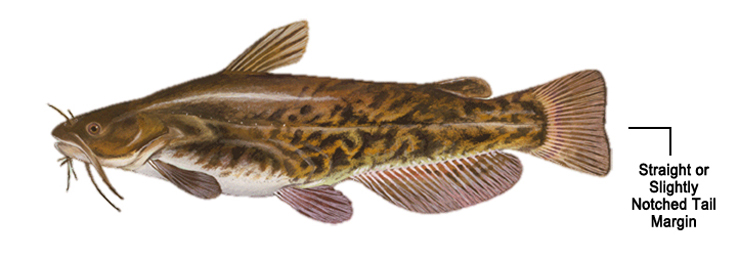
Blue Catfish
(Ictalurus furcatus)
Blue Catfish are long and often slender with a deeply forked tail. A distinguishing feature of the blue catfish is that the anal fin margin, or edge, is straight as if it has been clipped with scissors. All other catfish species have rounded anal fins.
Blue catfish are typically a bluish, gray color on top with a silvery or white underside. They are the largest of the catfish family in North America and can attain weights in excess of 100 pounds. The Maryland
state record blue catfish is 84 pounds.
As an introduced species, blue catfish are now commonly found in the tidal Potomac River and some of the other tributaries of the Chesapeake Bay. Studies are currently underway to determine their impact on other aquatic species.
More information about blue catfish can be found on the
Blue Catfish Page.
Introduced Catfish
Channel Catfish
(Ictalurus punctatus)
Deeply forked tail and anal fin with rounded margin. Slender body with spots on juveniles or small adults. Colors vary greatly and can range from light brown or gray In juveniles to a bluish-gray in larger fish. Anglers typically encounter channel catfish less than 24" in length in Maryland but larger fish can be found. Common in tidal freshwater but has also been extensively stocked In non-tidal waters.
More information about the channel catfish can be found on our
Fish Facts Page.
Native Catfish
White Catfish
(Ameiurus catus)
Moderately forked tail with rounded lobes. Anal fin with rounded margin. Generally a light gray color on back and sides with a white belly. Chin barbels are pale or white. Stocky body with large head. Commonly found 12-13" in length, rarely exceeding 6 lbs. No State record exists. Minimum size for consideration is 7 lbs. Common in tidal freshwater but has also been stocked in some non-tidal waters in Maryland.
More information about the white catfish can be found on our
Fish Facts Page.

Brown Bullhead
(Ameriurus nebulosus)
Straight or slightly notched tail margin. Light to dark mottled sides and lighter underside with dark chin barbels. Brown bullhead are typically small fish, less than 12" In length, but larger fish can be found . The Maryland
state record Bullhead is 3 lbs, 6 oz. Brown bullheads can be found in both tidal freshwater and non—tidal rivers, streams and ponds.

Yellow Bullhead
(Ameriurus natalis)
Rounded tail. Some specimens have obvious dark edges on their fins. Yellow bullhead are one of the smaller members of the Ictaluridae Family. Typically olive or yellow/brown on top with a yellow or cream underside. Yellow bullhead have cream colored chin barbels which differentiates them from other bullheads. Anglers often encounter Yellow Bullhead 10 inches in length or less but some fish can exceed 15 inches. Yellow Bullhead can be found in many of the tributaries of the Chesapeake Bay.
Species of note:
Margined Madtom (Noturus insignis)
Margined madtom is a small, light colored, secretive fish less than 6 inches in length. The long adipose fin is separated from the rounded tail (caudal fin) by a small notch. The vertical fins are darkly edged in clear water but may appear only dusky in turbid water. The upper jaw extends beyond the lower jaw. Typical size for a Margined Madtom is 3 – 5 inches. Margined madtoms can be found in gravelly riffles in streams.
Tadpole Madtom
(Noturus gyrinus)
Tadpole madtom is generally smaller than the margined madtom. The adipose is also nearly continuous with the caudal fin with only a small notch separating the two. The upper jaw is equal with the lower jaw. Tadpole madtoms are often darker gray or brown on the back, blending to a lighter color underneath. A dark line often runs along the side of the fish. Typical size for a tadpole madtom is 2-4 inches. They are usually found in small, low gradient streams.
Stonecat
(Noturus flavus)
Stonecats are similar to the madtoms in physiological appearance. They have a pale or cream-colored area located on the back and on the margin of the caudal fin. They have a depressed or flattened skull and their upper jaw is much longer that the lower. Typical size for a Stonecat is 4-9 inches. They are found in gravel or boulder streams in portions of Garrett County.